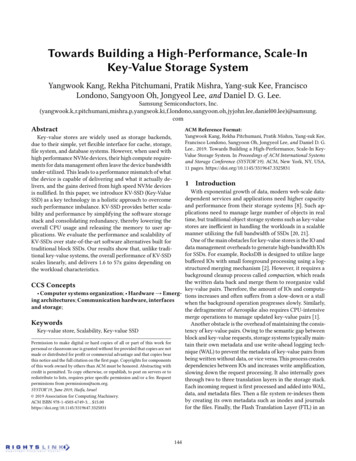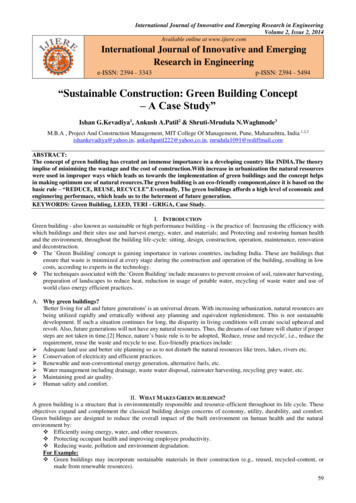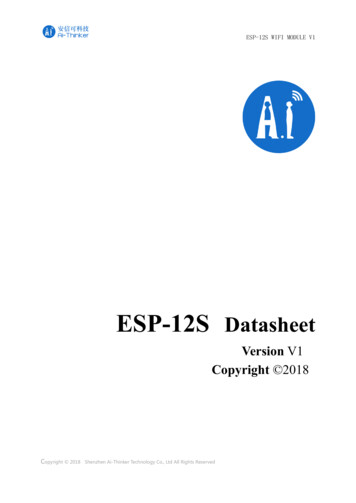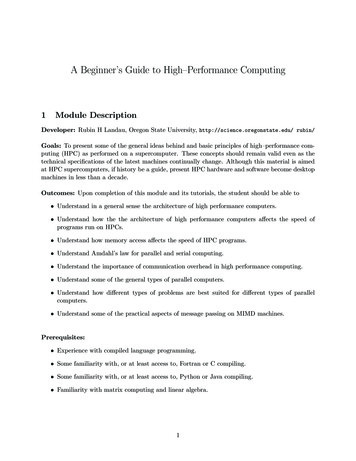
Transcription
Towards Building a High-Performance, Scale-InKey-Value Storage SystemYangwook Kang, Rekha Pitchumani, Pratik Mishra, Yang-suk Kee, FranciscoLondono, Sangyoon Oh, Jongyeol Lee, and Daniel D. G. Lee.Samsung Semiconductors, sung.comAbstractACM Reference Format:Yangwook Kang, Rekha Pitchumani, Pratik Mishra, Yang-suk Kee,Francisco Londono, Sangyoon Oh, Jongyeol Lee, and Daniel D. G.Lee. 2019. Towards Building a High-Performance, Scale-In KeyValue Storage System. In Proceedings of ACM International Systemsand Storage Conference (SYSTOR’19). ACM, New York, NY, USA,11 pages. https://doi.org/10.1145/3319647.3325831Key-value stores are widely used as storage backends,due to their simple, yet flexible interface for cache, storage,file system, and database systems. However, when used withhigh performance NVMe devices, their high compute requirements for data management often leave the device bandwidthunder-utilized. This leads to a performance mismatch of whatthe device is capable of delivering and what it actually delivers, and the gains derived from high speed NVMe devicesis nullified. In this paper, we introduce KV-SSD (Key-ValueSSD) as a key technology in a holistic approach to overcomesuch performance imbalance. KV-SSD provides better scalability and performance by simplifying the software storagestack and consolidating redundancy, thereby lowering theoverall CPU usage and releasing the memory to user applications. We evaluate the performance and scalability ofKV-SSDs over state-of-the-art software alternatives built fortraditional block SSDs. Our results show that, unlike traditional key-value systems, the overall performance of KV-SSDscales linearly, and delivers 1.6 to 57x gains depending onthe workload characteristics.1IntroductionWith exponential growth of data, modern web-scale datadependent services and applications need higher capacityand performance from their storage systems [8]. Such applications need to manage large number of objects in realtime, but traditional object storage systems such as key-valuestores are inefficient in handling the workloads in a scalablemanner utilizing the full bandwidth of SSDs [20, 21].One of the main obstacles for key-value stores is the IO anddata management overheads to generate high-bandwidth IOsfor SSDs. For example, RocksDB is designed to utilize largebuffered IOs with small foreground processing using a logstructured merging mechanism [2]. However, it requires abackground cleanup process called compaction, which readsthe written data back and merge them to reorganize validCCS Conceptskey-value pairs. Therefore, the amount of IOs and computa Computer systems organization; Hardware Emerg- tions increases and often suffers from a slow-down or a stalling architectures; Communication hardware, interfaceswhen the background operation progresses slowly. Similarly,and storage;the defragmenter of Aerospike also requires CPU-intensivemerge operations to manage updated key-value pairs [1].KeywordsAnother obstacle is the overhead of maintaining the consisKey-value store, Scalability, Key-value SSDtency of key-value pairs. Owing to the semantic gap betweenblock and key-value requests, storage systems typically mainPermission to make digital or hard copies of all or part of this work fortain their own metadata and use write-ahead logging techpersonal or classroom use is granted without fee provided that copies are notnique (WAL) to prevent the metadata of key-value pairs frommade or distributed for profit or commercial advantage and that copies bearbeing written without data, or vice versa. This process createsthis notice and the full citation on the first page. Copyrights for componentsdependencies between IOs and increases write amplification,of this work owned by others than ACM must be honored. Abstracting withcredit is permitted. To copy otherwise, or republish, to post on servers or toslowing down the request processing. It also internally goesredistribute to lists, requires prior specific permission and/or a fee. Requestthrough two to three translation layers in the storage stack.permissions from permissions@acm.org.Each incoming request is first processed and added into WAL,SYSTOR’19, June 2019, Haifa, Israeldata, and metadata files. Then a file system re-indexes them 2019 Association for Computing Machinery.by creating its own metadata such as inodes and journalsACM ISBN 978-1-4503-6749-3. . . 15.00for the files. Finally, the Flash Translation Layer (FTL) in anhttps://doi.org/10.1145/3319647.3325831144
SYSTOR’19, June 2019, Haifa, IsraelY. Kang et al.SSD performs an additional translation from logical blockaddresses (LBA) to physical page numbers (PBN).It has been challenging to reduce such overheads with lessCPU resources and smaller write amplification for high scalability and performance. These issues get more pronouncedfor fast storage devices due to shorter time budget for request processing. For example, to saturate a modern NVMeSSD that can process 4 KB requests at the rate of 600 MB/s, asystem needs to generate 150K 4 KB requests per second tothe device, which is less than 7 µs per request. If the averagerequest processing time of system increases to 30 µs, at least 4CPUs are required to generate the same rate of IOs to the device. Therefore, as the number of devices increases, the highCPU demand to saturates the devices intensifies resourcecontention in a host system, limiting in-node scalability.To alleviate these issues, we introduce KV-SSD that internally manages variable-length key-value pairs, providingan interface that is similar to that of conventional host-sidekey-value stores. By offloading the key-value managementlayer to an SSD, the need for host system resources can besignificantly reduced and the overhead of maintaining keyvalue pairs can be isolated within a device. Moreover, to ourbest knowledge KV-SSD is the first Key-Value SSD prototypethat supports large keys and unique functionalities such asiterator. Therefore, applications can directly communicatewith KV-SSDs without going through additional indirectionlayers for name and collision resolution.We design and develop KV-SSD on Samsung’s datacentergrade NVMe SSD hardware to study the performance implication of the in-storage key-value management in a realisticenvironment. We explore the potential benefits of KV-SSDto improve performance, resource-efficiency, and scalabilityfor key-value store applications, evaluating it against stateof-the art conventional key-value stores, such as RocksDBand Aerospike. We show that, unlike conventional key-valuestores, the aggregated performance of KV-SSDs scales linearly with the number of devices and fully utilize the deviceswith limited host-side compute and memory resources. Ourevaluation shows that when using 18 NVMe devices perNUMA node, KV-SSDs outperforms conventional key-valuestores by 1.6 to 57 times.2to design and develop KV-SSD, as an alternative to such keyvalue stores, thereby allowing applications to achieve higherthroughput and low latency with minimal (or no) hardwarechanges and low host resource usage.2.1Resource Demands of NVMe SSDsWe measured the resource usage of a block-based NVMeSSD to understand the minimum amount of resources (compute) required to saturate a SSD. Using flexible I/O testerfio, we performed both synchronous and asynchronousI/O benchmarks1 , varying the request sizes, the number ofthreads and queue depths with and without a file system. InFigure 1: Sequential I/O benchmark (fio 50 GB write)on block NVMe SSD with and without ext4 file system.Figure 1, we compare the throughput and CPU utilizationfor small (4KB) and large (64KB) block sizes; 100% utilizationrefers to the full utilization of all 48 cores of a NUMA node.We observe that saturating a device with synchronous I/Orequires from 1.3 up to 5.8 CPUs while asynchronous I/Ocan fill the bandwidth with 1.0 to 2.0 CPUs. Usually, largerblocks are more efficient as they can fill the device bandwidthwith fewer CPU resources and a smaller number of requests,although the average I/O latency increases [18]. Also, with afile system, the throughput is slightly lower in every case,even while using DIRECT I/O. Specifically, for the case ofone asynchronous I/O thread (Async 1t), the throughputwith file system experienced a huge drop compared to a rawdevice access, requiring one more CPU to saturate the device.Takeaway 1: At least one CPU needs to be dedicated tosaturate one NVMe device.Takeaway 2: More CPUs are required as the processingoverhead or the I/O hierarchy complexity increases. This isevident from the file system results discussed above.Therefore, the additional CPUs needed to this ideal resource usage of 1 CPU per device can serve as a metric forscalability comparison of each key-value store.Motivation and BackgroundIn this section, we describe the resource requirements ofvarious components in the I/O stack and their impact onutilizing low latency, and high-bandwidth SSDs. We firstinvestigate on the minimum resources required to saturateNVMe SSDs, and present the detailed analysis on the repercussions that the architectural designs of conventional keyvalue stores have on the amount of computing resourcesrequired for harnessing the potential of these NVMe devices. These consolidate the foundation for our motivation1 The145experimental testbed setup is described in Section 4.
Towards Building a High-Performance, Scale-In Key-Value Storage System2.2SYSTOR’19, June 2019, Haifa, Israelsystem. The write buffer size is kept small (128 KB for SSDs)as opposed to RocksDB, since there is no separate log writes,and by default multiple write buffers (upto 64 MB) are queuedin memory. As in any log-structured write scheme, over timethe records on disk blocks gets invalidated by updates anddeletes. A defragmenter process keeps track of active recordsand reclaims space by copying the active records to a different block. Aerospike performs best for an insert workload,irrespective of the key insertion order. A workload with updates/deletes will trigger the defragmenter and the associatedread and write amplification affect performance.RocksDB-SPDK is RocksDB with SPDK support, one thatenables RocksDB to use the user space SPDK drivers andthe associated SPDK Blobstore File system (BlobFS) to storeits files (Path 3). BlobFS is based on SPDK blobstore, whichowns and splits the entire device into 1 MB regions calledclusters. Blobstore manages parallel reads and writes to blobs,which consists of clusters. Blobstore avoids the page cacheentirely, behaving like DIRECT I/O. Blobstore also provideszero-copy, lockless, truly asynchronous reads and writes tothe storage device. All other working aspects except the one’sdiscussed above for RocksDB-SPDK is the same as RocksDB.By default WAL is disabled in SPDK support of RocksDB,i.e., RocksDB-SPDK, and turning it on resulted in crashesduring our tests. As WAL is integral to RocksDB’s design,evaluating RocksDB-SPDK without the log would be incorrect. For extensive comparison, RocksDB-SPDK performanceshows the impact of user-space drivers designed specificallyfor NVMe devices. We also compare single device performance RocksDB with and without WAL in our evaluationto make a educated guess about expected performance inproduction environments (refer to Section 5). Additionally,current RocksDB-SPDK environment is designed and hardcoded to use only one device with an entire database instance.We were unable to run with multiple devices or multiple instances on a single device, since the underlying SPDK devicestructure gets locked. Therefore, we modified the code to allow multiple devices and enable it to use multiple databases,one for each underlying device in an application with ashared environment supporting all underlying devices.Conventional Key-Value StoreMany conventional Key-Value storage applications arespecifically designed/optimized for NAND flash SSDs [1, 2, 9,15, 16, 22]. The resource consumption and processing overhead varies with each key-value store based on the architecture and objective of the key-value store. Figure 2 illustratesthe typical design of such key-value stores. These KV storestypically use one of three I/O paths to access the storagedevices, as shown in Figure 2:Path 1: Store user data on files and use the kernel file system,block cache, block I/O layers and kernel drivers;Path 2: Bypass the kernel file system and cache layers, butuse the block layers and kernel drivers;Path 3: Use of user-space libraries and drivers.We have chosen three representative popular host-sidekey-value stores following all three paths to illustrate theproblems faced by the host-side key-value stores, which aidin the design and evaluation of our work.Figure 2: Processes in conventional Key-Value Stores.RocksDB is a popular Log-Structured Merge (LSM) treebased key-value store, optimized for fast, low latency SSDsand follows Path 1. RocksDB buffers KV writes in a smallfixed-size (default 64 MB) in-memory index table, calledthe mem-table, and writes another copy to a write-aheadlog (WAL) for consistency. A configurable number of flushthreads persists the memtables to stable storage. The defaultI/O request size of flush thread’s is 1 MB. RocksDB has a background compaction process that re-organizes the user datafiles, which invokes many read and write operations, andcompetes with the foreground request processing threadsfor computation and I/O resources. Due to compaction, theperformance of all workloads suffers, while the overheadsassociated to compaction is minimized for sequential keyworkloads.Aerospike is a distributed NoSQL database and key-valuestore. Our work is based on a single node’s data storage performance and the in-node scale up potential, we limit ourscope to these aspects. Aerospike bypasses the kernel file system (Path 2) and utilizes native, multi-threaded, multi-coreread and write I/O patterns. Writes are buffered in-memoryand once full, the write-buffer is flushed to persistent storage.Writes to the SSDs are performed in large blocks and theseblocks are organized on storage like a log-structured file2.3Challenges and bottlenecksWith our understanding of the resource consumption requirements and architecture of conventional KV-stores alongwith the internals of the I/O stack, we summarize the majorchallenges and bottlenecks below. Multi-layer Interference: Along the odyssey of data access,user read or write requests typically travels through multiple I/O layers before being submitted to the device [19], asshown in Figure 3 (a). With increasing complexity of theI/O hierarchy, the delays associated to request processing146
SYSTOR’19, June 2019, Haifa, IsraelY. Kang et al.increases and makes it more difficult to debug problemsfaced in production environments. Resource contention: As discussed earlier, key-value storesneed to balance between several foreground and background processes. The foreground processes try to saturatethe SSD bandwidth with incoming user requests while thebackground processes concurrently organize the writtendata without hindering the execution of foreground ones.In practice, however, for utilizing the device bandwidth, asthe number of foreground processes increases, the workload on background processes also increases, which leadsto slowing down or stalling of the system. This limits thenode’s scalability as more CPUs are dedicated to supportsmaller number of high performance storage devices. Data consistency: A write-ahead log WAL is generally usedfor data consistency. Though it provides consistency, WALreduces user throughput by half as the total amount ofdata written doubles. Moreover, WAL generates sparseand low-bandwidth synchronous writes in the foreground.Even when buffered and written as large burst writes favored by SSDs, they are interleaved with key-value storespecific computations, increasing the inter-arrival time ofI/O requests and thus lowering the device utilization. Read and Write Amplification: In their pursuit of highperformance, key-value stores introduce processes likegarbage collection, compaction, and/or defragmentation.These significantly increases the read and write amplification as they need to read the written data back andprocess it. Large amount of buffer cache is also not quitehelpful when there are many devices installed due to cachepollution. Further, this amplification is in addition to theinternal read and write amplification caused by the SSD’sgarbage collection process. The amplification decreasesthe throughput and adversely affects the device lifetime.In the next section, we describe our solution, KV-SSD,as an alternative which takes into account the challenges,requirements and architectural limitations imposed by thecurrent I/O stack and provides a holistic approach to achieveboth performance and scalability of high performance SSDs.3applications but lacks practicality for modern data-centerworkloads. For example, variable-size application keys wouldstill require additional logs and data structures for translationof keys in the host as shown in Figure 3 (b). Moreover, KAMLalso lacks grouping of key-value pairs via the device interface.Therefore, the benefits derived from key-value interface canbe nullified due to key data management required in thehost.To mitigate the adverse impact of host-side key-valuemanagement, we develop and design Key-Value SSD(KV-SSD), which offloads the key-value management toSSD, taking into account such application requirements. Adedicated key-value management layer in each device canprovide advantages of isolated execution as well efficientlyharness the SSD internal system resources. Moreover,owing to a reduced semantic gap between storage devicesand key-value applications, KV-SSD brings the followingsoftware architectural benefits, which are discussed below.1. Lightweight Request Translation: Since variable-size keyvalue pairs are supported, key-value to block translationis no longer required. Applications can directly create andsend requests to KV-SSDs without going through any legacystorage stacks, resulting in reduced request processing andmemory overhead.2. Consistency without Journaling: It is not required to maintain metadata of key-value pairs at host side, eliminating theneed for journaling or transactions to store metadata anddata together. Consistency of key-value pairs is now managed inside KV-SSD, using its battery-backed in-memoryrequest buffers. Each key-value request is guaranteed tohave all or nothing consistency in a device. Therefore, forindependent key-value pairs, write-ahead logging (WAL)mechanism is not necessary on host-side.3. Read and Write Amplification Reduction: The host-side readand write amplification factors of KV-SSD remain to be anoptimal value of 1, because it does not require additionalinformation to be stored for key-value pairs. Internally, because variable-size keys are hashed before being written toan index structure, they still can be considered as fixed-sizekeys. Therefore, internal read and write amplification factorsin KV-SSD remained the same as that of random block readsand writes in block SSDs.4. Small Memory Footprint: Regardless of the number of keyvalue pairs in a device, the host memory consumption ofKV-SSD remains a constant. Its memory consumption can becalculated by multiplying the I/O queue depth by the size ofa key-value pair and the size of a value buffer. For example,if the queue depth is 64 and the maximum value size is 1 MB,which is large enough for most modern NVMe SSDs, andinternal data structure for each key-value pair is 64 B, theDesign of KV-SSDThe architecture of conventional host-side key-valuestores has evolved with the increasing performance of storage devices, but this development has been limited by theincreasing demands for host system resources per device. Figure 3 shows the I/O path for three key-value stores namely,the conventional block SSD, KAML SSD [11], and our KVSSD. We observe that with increasing layers of I/O hierarchy,the delay associated to I/O access also increases.While KAML provides basic key-value interface, i.e. putand get with fixed-size 8 B key and variable-size values to147
Towards Building a High-Performance, Scale-In Key-Value Storage SystemManager sends the key-value pair to flash channels. TheIndex Manager also takes the first 4 B of the key for bucketinginto containers known as iterator buckets, which is used forgrouping all keys with the same 4 B prefix.Large variable-sized key Support: KV-SSD is designed tosupport both variable-sized values and keys. The support forvariable-size keys provides the opportunity for applicationsto encode useful information such as name and type, andmore importantly eliminates the requirement of maintaining additional logs and indices for name resolution, therebysimplifying the I/O stack, refer to Figure 3 (c). The key-valuecommands with large keys are implemented as two separateNVMe transfers in KV-SSD due to the limited size of NVMecommand packets, which can slightly increase transfer latency.Iterator support: Key-value applications often requiregroup operations to maintain objects. This includes rebalancing, list, recovery, etc. To support these operations,KV-SSD provides support for iterators, which can list, create, or remove a group. Internally, all keys matching MSB4 B key keys are containerized into iterate bucket as shownin Figure 4. This buckets are updated in a log-structuredmanner whenever put or delete operation is processed andperiodically, cleaned up by GC, as described later.total amount of memory required to support one device isaround 4 KB for keys and 64 MB for values.Additionally, KV-SSD allows key-value store applicationsto easily adopt a shared-nothing architecture as there is nomain data structures to be shared between devices. By doingso, the scalability limitation from synchronization effectscan be avoided. It can avoid lock contentions on shared datastructures and also eliminate on-demand reads for looking upthe metadata associated with a given request. To demonstratethese benefits, we design and implement a prototype deviceon top of an existing enterprise-grade Samsung NVMe SSD.On the host side, we provide an NVMe device driver thatsupports vendor-specific key-value commands and the APIlibrary that communicates with the driver.3.1SYSTOR’19, June 2019, Haifa, IsraelIn-Storage Key-Value ManagementTo realize the concept, we added support for variable-sizekeys and values to existing block-based SSD firmware. Wedesigned KV-SSD to follow similar data processing flow asin the block firmware and meet its latency requirement toreuse its internal hardware resources and events designedfor block requests, including interrupts, memory and DMA(direct memory access) engines. The code for each task isstored in SRAM, and the indices for the main index structureare stored in a battery-backed DRAM as with normal blockbased SSDs. In this section, we discuss the working detailsof our prototype KV-SSD.3.1.2 FTL and Indexing: Block-based FTL is extended tosupport a variable-size key-value pairs. Traditional pagebased or block-based mapping technique using LBA as a keycannot be used as a main index structure in KV-SSD as therange of keys is not fixed. We use a multi-level hash tablefor fast point query as a global index structure in KV-SSD.A global hash table is designed to have all key-value pairsin the device, and shared by all Index Managers. Each IndexManager has a local hash table to temporarily store updatesto reduce a lock contention on the main table. This local hashtable is associated with a bloom filter to reduce the numberof memory accesses to the index structure on reads for quickmembership checking.3.1.1 Command processing: Our key-value commands arecurrently implemented as NVMe vendor-specific commands.We include 5 native commands for practicability: put, get,delete, exist, and iterate, as shown in Figure 3. The put andget commands are similar to the write and read commandsof block devices, with additional support for variable sizedkeys and values. The delete command removes a key-valuepair. The exist command is designed to query the existenceof multiple keys using a single I/O command. Finally, theiterate command enumerates keys that match a given searchprefix, which is represented by a 4 B bitmask in KV-SSD.The key-value requests are designed to be executed in apipeline manner, passing requests between tasks running ineach CPU as shown in Figure 4. To process a put request,for example, the command header is first fetched from thedevice I/O queue and passed to Request Handlers. Then, thecommunication between the device driver and the device isinitiated to transfer the key-value pair from the host system.Once the data becomes ready in the device DRAM, RequestHandler passes the request to an Index Manager. As shownin Figure 4, the Index Manager first hashes the variable sizedkey to fixed length key inside the device and stores in thelocal hash table, which is then merged to the global hashtable for physical offset translation, and finally the Index3.1.3 Garbage Collection: The garbage collector (GC) inan SSD is changed to recognize the key-value pairs stored ina flash page and updated keys in the iterator buckets. During cleaning, GC scans the keys in flash pages, checks theirvalidity by looking them up in the global index structure,and discards the key-value pairs that are already deleted.The victim selection and cleaning policy is the same as blockfirmware, with addition to managing the global hash tableand iterator buckets.3.2KV Library and DriverKV-SSD library provides a programming interface to userapplications. It includes a wrapper for raw key-value command sets and extra features, such as memory management,148
SYSTOR’19, June 2019, Haifa, IsraelY. Kang et al.Figure 3: Comparative I/O storage stack for key-value stores based on (a) Conventional block SSD; (b) KAML SSD;(c) Samsung KV-SSD, respectively. More the layers in the I/O hierarchy, higher is the delay in data processing4Experimental SetupWe use a custom designed storage node, MissionPeak withUbuntu v16.04. The I/O bandwidth of one NUMA node is24 GB/s, which can saturate 12-18 NVMe devices. The serveris configured with abundant resources for scalability tests:756 GB of memory, two Xeon E5 2.10Ghz, each having 48CPUs with hyper-threading.For multi-device configuration, we decided to use shardingrather than RAID. This is because we found that having multiple physical devices in one RAID device can suffer from I/Oqueue contention while sharding provides unique key-spacefor each key-value store, thereby ensuring isolation. Our experiment using 18 NVMe SSD with 144 instances of RocksDBalso shows that sharding provides 3.4x performance, compared to one RAID-0 device that has 18 physical devices.Existing benchmark programs for key-value stores, suchas YCSB [7], are not designed for measuring the aggregatedperformance from multiple key-value stores running on multiple storage devices. This is crucial for our scalability evaluation as one instance of key-value store cannot saturate aNVMe SSD. Also, running multiple processes of the benchmark instead does not guarantee each process to be launchedat the same time and executed concurrently.We develop KVSB to coordinate the execution of multiple instances of key-value stores. KVSB assigns an availableCPU to each key-value store and uses the memory from thesame NUMA node. It has two phases of execution. In theinitialization phase, all instances of a key-value store arecreated in separate threads and other resources are preparedsuch as memory pools. The execution phase starts when allinstances becomes ready, running a combination of insert,update, read, or delete requests based on a given requestdistribution function.Figure 4: Data Flow in KV-SSD.key-value LRU cache, synchronous and asynchronous I/Os,sorting, and a KV-SSD Emulator that mimics the behaviorof KV-SSDs in memory. By default, KV library internallyuses non-blocking, asynchronous I/O for performance. Synchronous I/O is simulated on top of asynchronous I/O usingmutex.Typically, the support for asynchronous I/O is provided inthe block I/O layer in the kernel, but since KV-SSD applications bypasses kernel I/O stack, we moved the functionalityto our KV driver. Whenever the I/O is completed, the KVdriver stores the results of I/O in kernel memory and send asignal to event file descriptors. Then, users waiting for I/Ocompletion using select() or epoll() will be notified.KV-SSD also provides user-level NVMe drivers based onSPDK (Storage Performance Development Kit) [10], whichsupports memory management using hugepages and asynchronous I/O APIs. Performance-wise, we have found no significant differences between the drivers. For example, whileSPDK driver provides more control on assigning CPUs perits I/O queue, the multiple queue support in the latest kernels can provide the similar benefits. We chose to use theuser-level driver in the evaluation for debugging purpose.149
Towards Building a High-Performance, Scale-In Key-Value Storage System5devices used and other resource constraints for our scalabilityexperiments. Further, we examined if the performance scaleslinearly with increasing number of devices and the impactwhen more background processing is needed.EvaluationWe compare the performance and scalability of KV-SSDagainst conventional key-value stores using KVSB. Using thebest performing and resource-efficient configuration for asingle device as a baseline, the scalability of each key-valuestore is measured by increasing the number of devices andadjusting the configuration accordingly.5.1SYSTOR’19, June 2019, Haifa, IsraelResource Demands of Key-Value StoresTo understand the CPU requirement of key-value stores,we measure the normalized
cation of the in-storage key-value management in a realistic environment. We explore the potential benefits of KV-SSD to improve performance, resource-efficiency, and scalability for key-value store applications, evaluating it against state-of-the art conventional key-value stores, such as RocksDB and Aerospike.











